tire size AUDI A6 2015 Owners Manual
[x] Cancel search | Manufacturer: AUDI, Model Year: 2015, Model line: A6, Model: AUDI A6 2015Pages: 314, PDF Size: 77.57 MB
Page 200 of 314

198 Intelligent technology
Winter tires
When dr iv ing in the w inter, your ve hicl e w ith
a ll-whee l drive has an advantage,
even with
regular ti res . In winter road conditions it may
be advisable to mount winter tires (o r all-sea
son t ires) for improved driveability and brak
ing: these tires must be mounted on
all four
whe els .
See also c:> page 264, Winter tires.
Tire chains
Where tire cha ins are mandatory on certa in
roads, th is normally a lso applies to vehicles
with a ll-wheel drive
c:> page 265, Snow
chains.
Replacing wheel s/tir es
Vehicles w ith all-wheel drive must a lways
have tires of the same size . Also avoid tires
with d ifferent tread depths. For details see
page
c:> page 257, New tires and replacing
tires and wheels.
Off-Road driv ing?
Your Audi does not have enough ground clear
ance to be used as an off-road ve hicle . It is
therefore best to avoid rough tracks and un
even terrain as much as possible. Also refer to
c:> page 201.
A WARNING
Always adjust your driving to road and traf
fic conditions . Do not let the ext ra safety
afforded by all-wheel dr ive tempt you into
taking extra risks.
- Alt hough the all-whee l dr ive is
very ef
fec tive, a lways remember that b raking
c ap aci ty is limited by tire traction. Yo u
sho uld the re fo re not dr ive at excessive
speeds on icy or slippery road su rfaces.
- O n wet road s urfa ces, be c areful not to
drive too fast because the front wheels
cou ld begin to sli de on top of the water
(aq uaplaning) . If this sho uld occ ur, you
will have no warn ing from a sudden in
crease in engine speed as with a front
w heel d rive vehicle. A lways drive at
speeds w hich are suited to the road con
ditions -risk of c rash.
Energy management
Starting ability is optimized
Energy management controls the distribution
of electrical energy and thus optimizes the
availability of electrical energy for starting the engine.
If a vehicle with a conventiona l energy system
is not driven for a long period of t ime, t he bat
te ry is discharged by idling current consume rs
(e .g. immobili ze r). In certa in circumstan ces it
ca n res ult in the re be ing insu ffic ien t energy
available to start the eng ine.
Intelligent energy management in your vehi
cl e ha ndles the dist rib ution o f electr ica l ene r
gy. Start ing abili ty is m arke dly improved and
the life of the battery is extended .
Bas ica lly, energy management consists of
battery diagnosis , idling current manage
ment
and dynamic energy management .
Battery diagnosis
Battery diagnosis continuously determines
the state of the batte ry. Sensors determine
batte ry voltage, batt ery cu rr e nt and battery
tempe ratu re. This de termines the cur ren t
sta te o f cha rge and t he power o f th e battery.
Idling current management
Idli ng cur rent management reduces energy
consumpt ion while the vehicle is standing .
With the ig nition sw itched off, it controls the
energy supp ly to the variou s ele ctri ca l compo
nen ts. Da ta from ba ttery d iagnos is is co nsid
ered.
Depend ing on the batte ry's state of cha rge,
i ndivid ual con sume rs are g radually turned off
to prevent excessive discharge o f the battery
and th us main tain starting capabi lity.
Dynamic energy management
While the vehicle is being d riven, dynamic en
ergy ma nagement distr ib utes the energy ge n
era ted a ccord ing to t he needs of the indivi du-
al components .
It regula tes consumption, so
t h at more electrical energy is not being used ..,.
Page 242 of 314
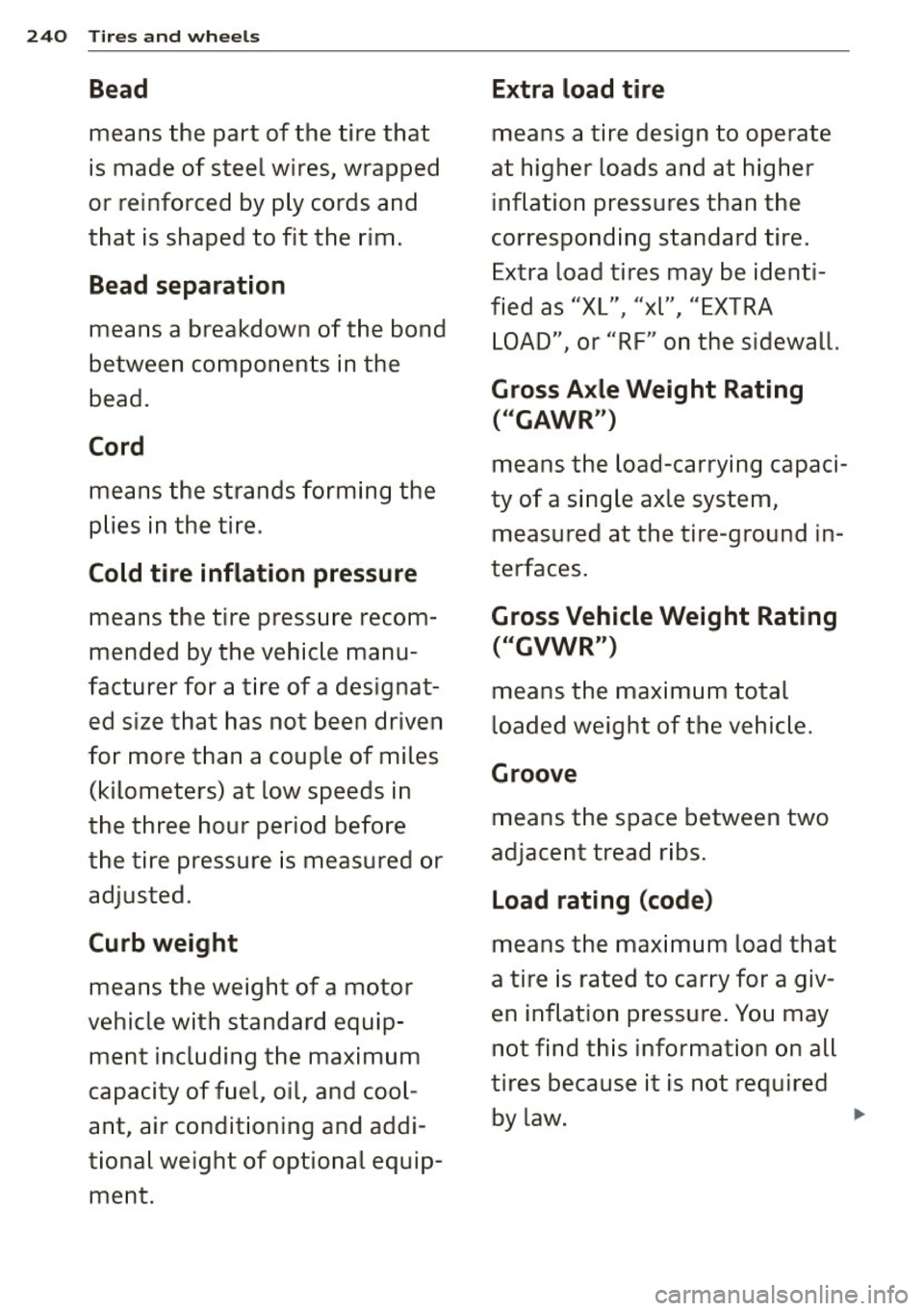
240 Tires and whee ls
Be ad Extra load t ire
means the part of the tire that means a tire design to operate
is made of steel wires, wrapped at higher loads and at higher
or reinforced by ply cords and inflation pressures than the
that is shaped to fit the rim . corresponding standard tire.
Bead separation Extra load tires may be identi-
fied as "XL", "xl", "EXTRA
means a breakdown of the bond LOAD", or "RF" on the sidewall.
between components in the
bead .
Gross A xle Weight Rating
(" GAWR ")
Cord
means the load-carrying capaci-
means the strands forming the ty of a single axle system,
p lies in the tire .
measured at the tire-ground in-
Cold tire inflation pressure terfaces.
means the tire pressure recom-
Gross Vehicle Weight Rating
mended by the vehicle manu-( "GVWR ")
facturer for a t ire of a designat-
means the maximum total
ed size that has not been driven loaded weight of the vehicle.
for more than a couple of miles
Groove
(kilometers) at low speeds in
the three hour period before means the space between two
the tire pressure is measured or adjacent tread
ribs.
adjusted.
Load rating (code)
Curb weight
means the max imum load that
means the weight of a motor a tire
is rated to carry for a giv-
vehicle with standard equip -en inflation pressure
. You may
ment including the maximum not find
this information on all
capacity of fuel, oil , and cool- tires because it is not required
ant, air conditioning and addi- by law.
...
tiona
l weight of optional equip-
ment.
Page 244 of 314
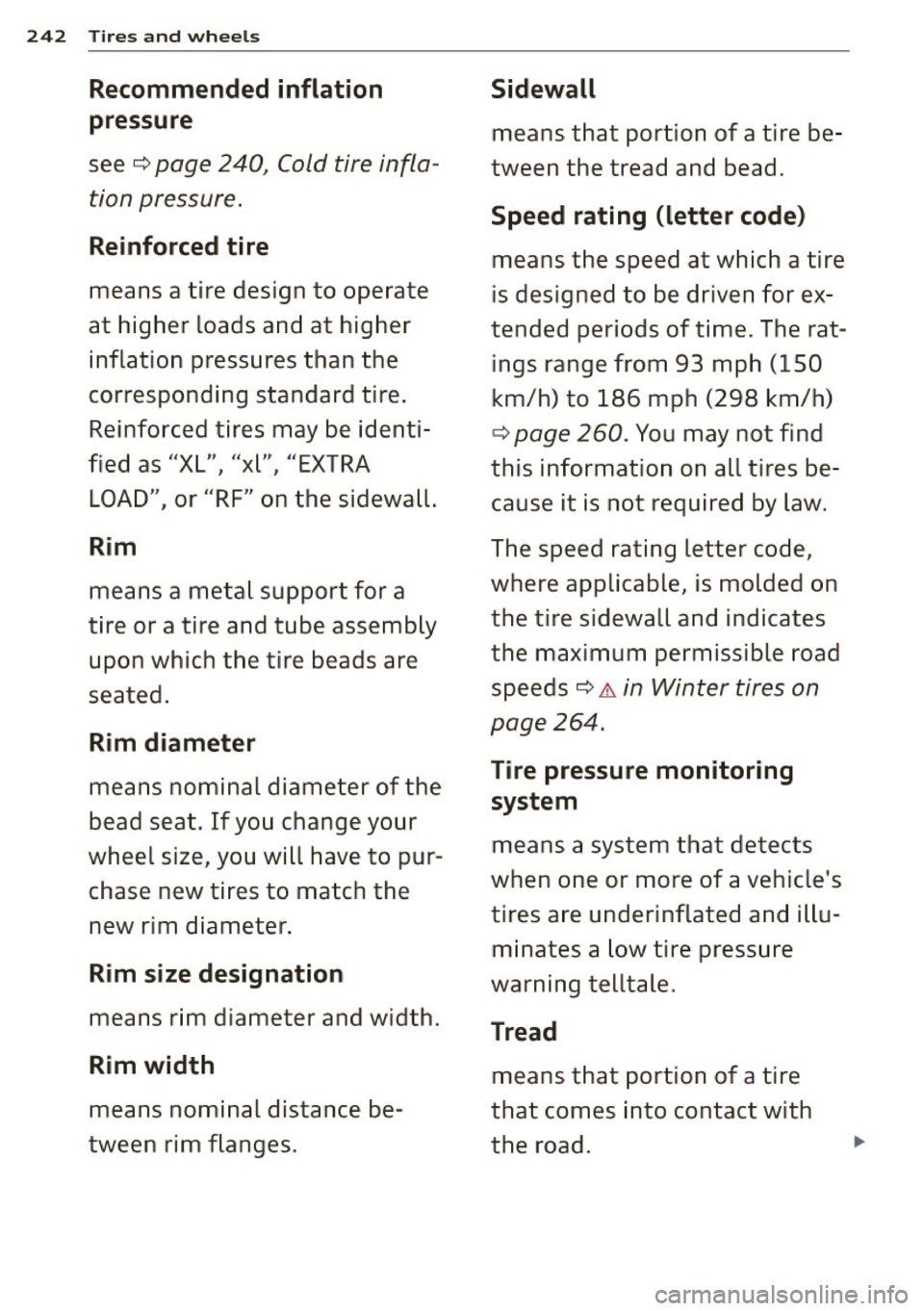
242 Tires and whee ls
Recommended inflation Sidewall
pressu re
means that portion of a tire be -
see
c:::> page 240, Cold tire infla-tween the tread and bead.
tion pressure.
Spe ed rating (letter code )
Reinforced tire
means the speed at which a tire
means a tire design to operate
is designed to be driven for ex-
at higher loads and at higher tended periods of time. The rat-
inflation pressures than the ings range from 93 mph (150
corresponding standard t ire .
km/h) to 186 mph (298 km/h)
Reinforced tires may be identi -
c:::> page 260. You may not find
fied as "XL", "xl", "EXTRA
this information on all tires be-
LOAD", or "RF" on the sidewall.
cause it is not required by law.
Rim The speed rating letter code,
means a meta l support for a where applicable
, is molded on
tire or a tire and tube assembly the tire sidewall and indicates
upon which the tire beads are the
maximum pe rmissible road
seated . speeds
c:::> A in Winter tires on
Rim diameter
page 264.
means
nominal diameter of the
Tire pressure monitoring
system
bead seat. If yo u change your
means a system that detects
wheel size, you will have to pur-
chase new tires to ma tch the when one or more of a vehicle's
new rim diameter . tires a
re underinflated and illu-
Rim size designation
m inates a low tire pressure
warning telltale.
means rim diameter and width.
Tread
Rim width
means that portion of a tire
means nominal distance be-
that comes into contact with
tween rim flanges. the road.
...
Page 247 of 314

Tires and wheels 245
Tire pressure generally refers to tant things you can do to help •
the amount of air in a tire that avoid sudden tire failure. Un-• '
it needs it to do its job and derinflated tires are a major
safely carry the combined load cause of sudden tire failure. of the entire vehicle and its con- Keeping tires at the right pres-
tents. Tire pressure is measured sure is also important for safe
in kilopascals (kPa), the inter- and responsive vehicle han-
national measuring unit and in dling, traction, braking and
pounds per square inch (PSI) . load carrying.
Tire pressures
Tire pressure is based in part on are particularly important
the vehicle's design and load when the vehicle is being driv-
limit - the greatest amount of en at higher speeds, and then
weight that the vehicle can car -especially when heavily loaded
ry safely and the tire size. The even within the permissible
proper tire pressure is frequent-load-carrying capacities ap-
ly referred to as the "recom-proved for your vehicle.
mended cold tire inflation pres-The recommended tire pres-
sure ." Air in the tires expands
sures for your Audi depend on
when the tire heats up because the kind of tires on your vehicle
of internal friction when it flex- and the number of passengers
es in use. The tire pressure is and/or amount of luggage you
higher when the tire has will be transporting.
warmed up than when it is The tire pressure label is locat-
"cold. " It is the inflation pres-
ed on the driver's side B-pillar.
sure in a "cold" tire that counts.
Therefore, you should never let The tire pressure label lists the
recommended cold tire infla-
air out of a warm tire to match
"cold tire inflation pressure" tion pressures for the vehicle at
its maximum capacity weight
recommendations. The tires
would then be underinflated and tires that were on your ve
-
and could fail suddenly. hicle at the time it was manu-
M factured
. N
0
Maintaining proper tire pres-<.J 'SI: ,...., \!)
sure is one of the most impor-1.1'1 ,...., 1.1'1 ,....,
Page 248 of 314

246 Tires and wheel s
If you wish to improve comfort See the illustration ¢ fig. 195
when operating the vehicle at for the locati on of the labe l on
normal load (up to 3 occu -driver's side B -pillar (color of
pants), you can adjust tire the actual label and exact loca-
pressures to those specified tion on the vehic le will vary
for normal vehicle load. Before slight ly) .
operat ing the vehicle at maxi -Note that the following table is
mum load , you must increase accurate at the time of going to
the ti re pressu res to those press and is subject to change .
specified for maximum vehicle In the event of discrepancies,
load¢&. the tire pressure labe l is locat-
Bear in mind that the tire pres- ed on the driver's side 8-pi llar
sure monitoring system can on -always takes precedence .
ly monitor the tire pressures The table below lists the rec-
you have stored . The system
ommended cold tire inflation
does not recogn ize the load
pressures for the Audi model
condition of your vehic le.
covered by your Owner's Litera-
T he effectiveness of the tire ture at the vehicle's capacity
pressure monitoring system weight and the tire sizes instal -
will be impaired if you store led on the respective mode ls as
normal load pressures but then original equipment, or as a fac-
operate the vehicle at its maxi- tory option.
...
mum load¢&.
Page 249 of 314
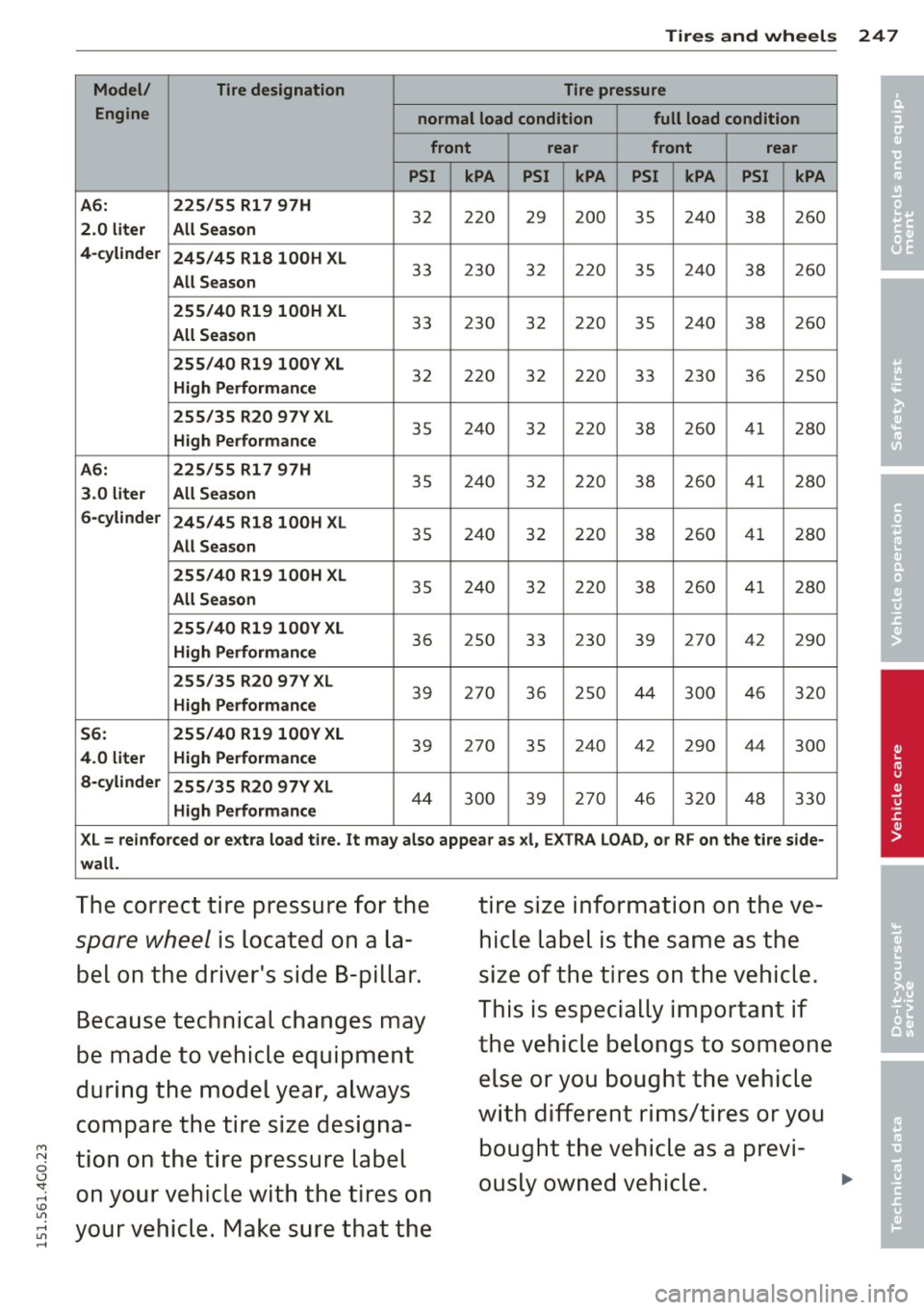
Tires and wheels 24 7
Model/ Tire designation Tire pressure
• Engine
normal load condition full load condition
•
front rear front rear
PSI kPA PSI
kPA PSI kPA PSI kPA
A6: 225/55 Rl 7 97H
32 220 29 200 35 240
38 260 2.0 liter All Season
4-cylinder 245/45 Rl8 lOOH XL
All Season
33 230 32 220 35 240 38 260
255/40 Rl9 lOOH XL
33 230 32
220
35 240
38 260 All Season
255/40 Rl9 lOOY XL
32 220 32 220 33 230 36 250 High Performance
255/35 R20 97Y XL
35 240 32 220 38 260 41 280 High Performance
A6: 225/55 Rl 7 97H
35 240
32 220 38 260 41
280 3.0 liter All Season
6-cylinder
245/45 Rl8 lOOH XL
All Season
35 240 32 220 38 260 41 280
255/40 Rl9 lOOH XL
35 240
32 220
38 260
41 280 All Season
255/40 Rl9 lOOY XL
36 250 33 230 39 270
42
290
High Performance
255/35 R20 97Y XL
39 270 36 250 44 300 46 320 High Performance
S6: 255/40 Rl9 lOOY XL
39 270
35 240 42 290 44
300 4.0 liter High Performance
a-cylinder 255/35 R20 97Y XL
High Performance
44 300 39 270 46
320 48
330
XL= reinforced or extra load tire . It may also appear as xl, EXTRA LOAD, or RF on the tire side-
wall.
The correct tire pressure for the tire size information on the ve-
spare wheel is located on a la- hicle label is the same as the
bel on the driver's side B-pillar. size of the tires on the vehicle.
Because technical changes may This is especially important if
the vehicle belongs to someone
be made to vehicle equipment
during the model year, always else or you bought the vehicle
with different rims/tires or you
compare the tire size designa-
M
tion on the tire pressure label bought the vehicle as a previ-N
0 <.J ously owned vehicle. ... 'SI: on your vehicle with the tires on ,...., \!) 1.1'1 ,...., your vehicle. Make sure that the 1.1'1 ,....,
Page 258 of 314

256 Tires a nd whee ls
Driving style - Extra care must be ta ken when
Driving fast around curves , rotat
ing direction-specific
heavy acceleration and hard tires
¢
page 2 77.
b raking increase tire wear.
Wheel balancing
Rotating tires for more even
The wheels on new vehicles are
wear ba lanced. However, various sit-
For all four tires on your vehicle uations during everyday driving
to have the same service life, can cause them to become un-
we recommend that the front balanced, resulting in vibra-
and rear tires are rotated ac -tions you can usually feel
cording to the tire manufactur- through the steering wheel.
er's suggested tire rotation in- Unbalanced wheels must be re-
tervals . Please remember the
balanced to avoid excessive
following: wear on steering, suspension
-T ire rotation intervals may dif -and tires. A wheel must also be
fer from the vehicle service in· rebalanced when a new tire is
tervals outlined in your War- insta
lled.
ranty
& Maintenance booklet . Incorrect wheel alignment
-The longer one tire is used in
Incorrect wheel alignment can
one location on the vehicle,
cause excessive tire wear, im-
the more it wears at certain
pairing the safety of the vehi-
points; therefore, we recom-
cle. If tires show excessive
mend that you follow the tire
wear, have the wheel alignment
manufacturer's suggested tire
checked by an authorized Audi
rotation intervals.
dealer or qualified workshop.
-Vehicles with front-wheel
dr ive experience more t read
All-wheel drive
wear on the front wheels com-
Vehicles with quattro must al-
pared to all-wheel drive (quat- ways have tires of the same
tro) .
size, construction and tread
-Please rotate tires as shown type. For details see
¢
fig . 198. ¢page 197. ...
Page 264 of 314
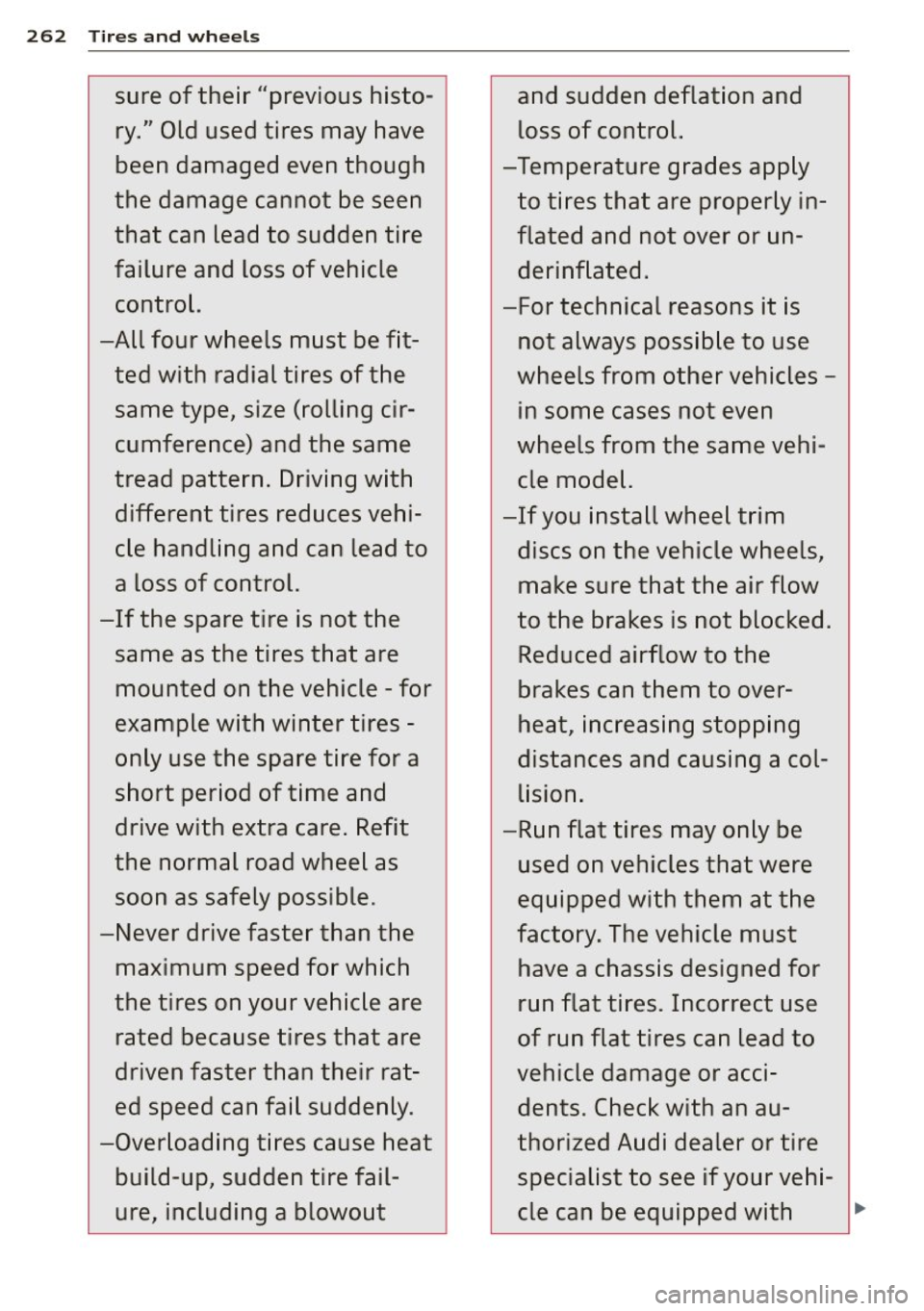
262 Tires and wheels
sure of their "previous histo-
and sudden deflation and
ry." Old used tires may have loss of control.
been damaged even though -Temperature grades apply
the damage cannot be seen to tires that are properly in-
that can lead to sudden tire flated and not over or un-
failure and loss of vehicle derinflated.
control. -For technical reasons it is
-All four wheels must be fit- not always possible to use
ted with radial tires of the wheels from other vehicles -
same type, size (rolling cir- in some cases not even
cumference) and the same wheels from the same vehi-
tread pattern. Driving with cle model.
different tires reduces vehi- -If you install wheel trim
cle handling and can lead to discs on the vehicle wheels,
a loss of control. make sure that the air flow
-If the spare tire is not the to the brakes is not blocked.
same as the tires that are Reduced airflow to the
mounted on the vehicle -for
brakes can them to over-
example with winter tires -
heat, increasing stopping
only use the spare tire for a distances and causing a col-
short period of time and lision.
drive with extra care. Refit -Run flat tires may only be
the normal road wheel as used on vehicles that were
soon as safely possible. equipped with them at the
- Never drive faster than the
factory. The vehicle must
maximum speed for which have a chassis designed for
the tires on your vehicle are run flat tires. Incorrect use rated because tires that are of run flat tires can lead to
driven faster than their rat- vehicle damage or acci-
ed speed can fail suddenly. dents. Check with an au-
-Overloading tires cause heat thorized Audi dealer or tire build-up, sudden tire fail -specialist to see if your vehi -
ure, including a blowout cle can be equipped with
..
Page 266 of 314
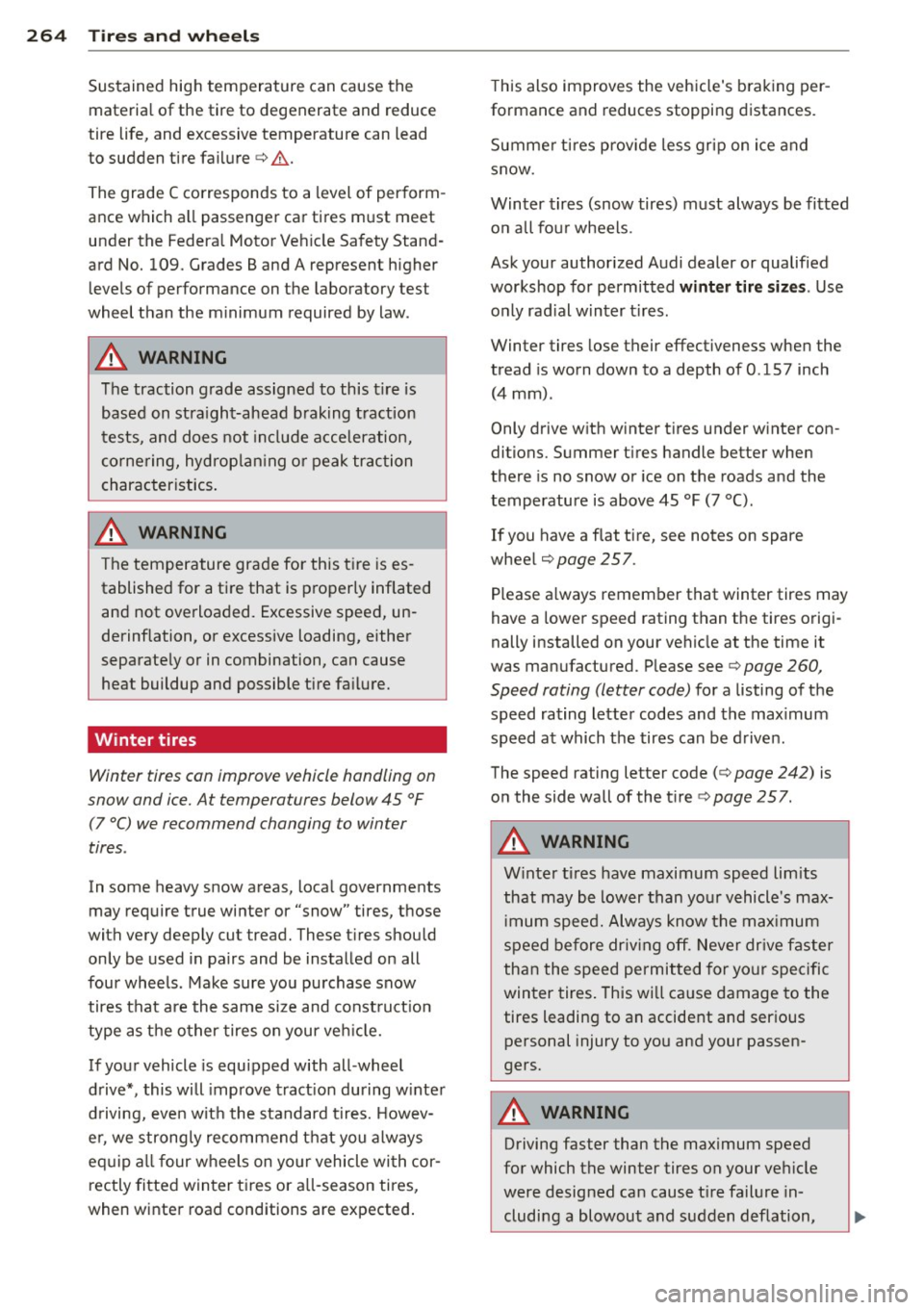
264 Tire s and wheel s
Sustained high temperature can cause the
materia l of the tire to degenerate and reduce
tire life, and excessive temperature can lead
to sudden tire failure<=>,& .
The grade C corresponds to a level of perform
ance which a ll passenger car tires must meet
under the Federa l Motor Veh icle Safety Stand
ard No.
109. Grades Band A represent higher
levels of performance on the laboratory test
wheel than the m inimum required by law .
A WARNING
The traction grade assigned to this t ire is
based on stra ight-ahead braking traction
tests, and does not include acceleration,
corne ring, hydrop lan ing o r peak traction
character istics .
A WARNING ,.,.____
The temperature grade for this tire is es
tablished for a tire that is p roperly inflated
and not overloaded. Excessive speed, un
derinflation, or excessive loading, either
separate ly or in combination, can cause
heat buildup and possible tire fa ilure.
Winter tires
Winter tires can improve vehicle handling on
snow and ice. At temperatures below 45 °F
(7 °C) we recommend changing to winter
tires .
In some heavy snow areas, loca l governments
may require true winter or "snow" tires, those
with very deeply cut tread. These t ires should
only be used in pairs and be installed on all
four wheels. Make sure yo u purchase snow
tires that are the same size and const ruct ion
type as t he other tires on your ve hicle.
If your vehicle is equ ipped with all -wheel
drive*, this will improve t ract ion during w inter
d riving, even wit h the standard tires. Howev
e r, we strong ly recommend that you always
eq uip a ll four w heels on yo ur vehicle wi th cor
rectly fitted win ter tires or a ll-season tires,
when winte r road conditions are expected . This also improves the veh
icle's brak ing per
formance and reduces stopping distances.
Summe r tires p rovide less gr ip on ice and
snow.
Winter tires (snow tires) must always be fitted on all fou r wheels .
Ask your authorized Audi dealer or qualified
workshop for perm itted
winter tire siz es. Use
o n ly rad ial winter t ires .
Winter tires lose their effectiveness when the
tread is worn down to a depth of
0 .157 inch
(4 mm).
Only drive w ith w inter t ires under winter con
ditions. Summer t ires handle better when
there is no snow or ice on the roads and the
temperature is above 45 °F (7 °() .
If you have a flat tire, see notes on spare
wheel
<=>page 257.
Please a lways remember that winter tires may
have a lower speed rating than the tires origi
nally installed on your vehicle at the time it
was manufactured. P lease see<=>
page 260,
Speed rating (letter code)
fo r a listing of the
speed rating lette r codes and the max imum
speed at which the tires can be d riven .
The speed rating letter code (<=>
page 242) is
on the side wall of the t ire
c> page 257.
A WARNING ,.___
W inter t ires have maximum speed lim its
that may be lower than yo ur vehicle's max
i mum speed. Always know the max imum
speed before dr iv ing off. Never dr ive faster
than the speed permitted for yo ur specific
winter tires . This wi ll ca use damage to the
tires leading to an accident and ser ious
personal injury to you and your passen
gers.
A WARNING
'----
Driving faster than the maximum speed
for which the winter tires on your vehicle were designed can cause t ire failure in
cluding a blowout and sudden deflation,
Page 267 of 314
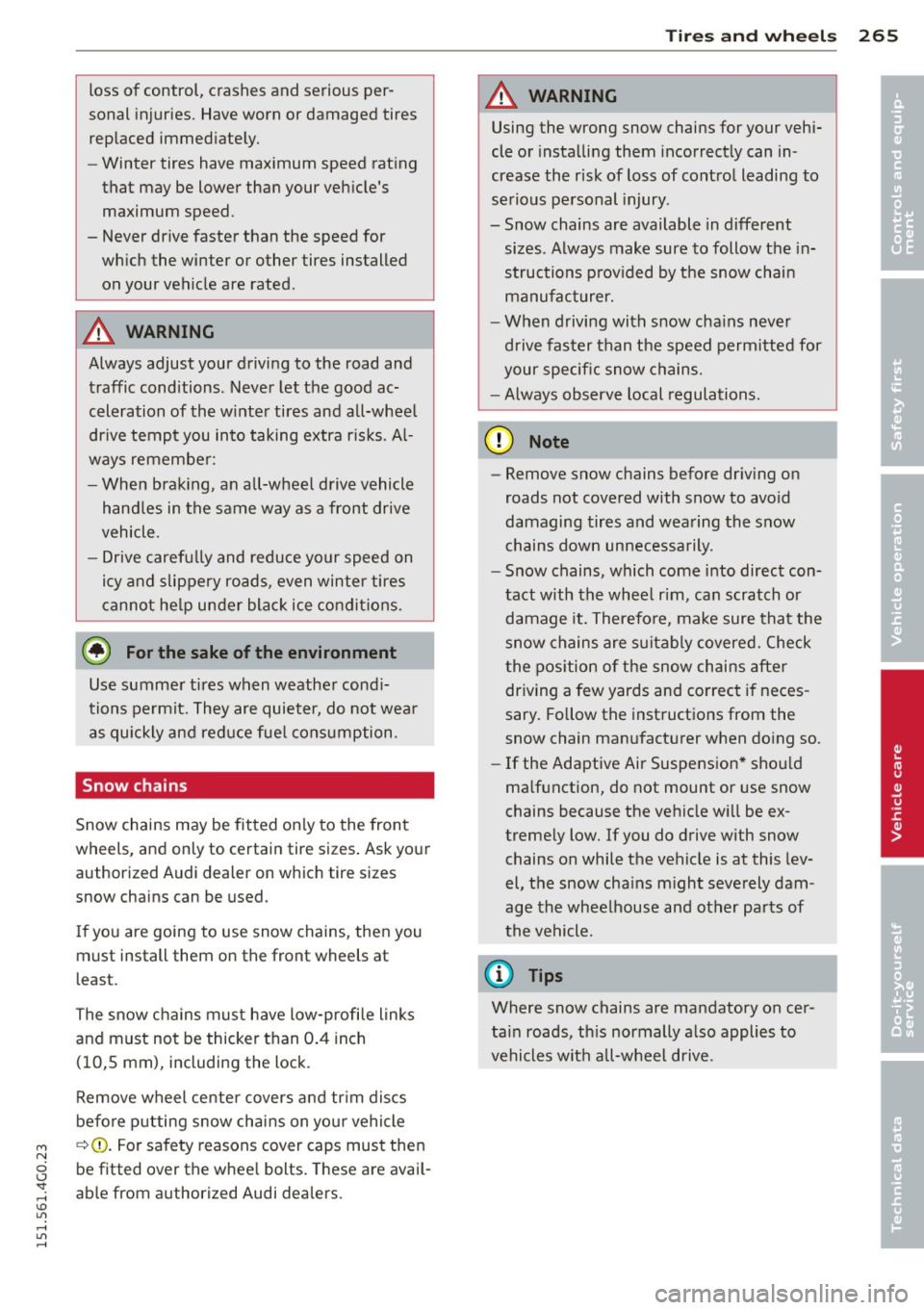
M N
0 <.J 'SI: ,...., \!) ..,.,
,...., ..,., ,....,
loss of control, crashes and serious per
sonal injuries . Have worn or damaged tires
replaced immediate ly.
- Winter tires have maximum speed rating
that may be lower than your vehicle's
maximum speed.
- Never drive faster than the speed for
which the winter or other tires installed
on your vehicle are rated.
A WARNING
Always adjust your driving to the road and
traffic conditions. Never let the good ac
celeration of the winter tires and all-wheel
drive tempt you into taking extra risks. Al
ways remember:
- When braking, an all-wheel drive vehicle
handles in the same way as a front drive
vehicle.
- Drive carefully and reduce your speed on
icy and slippery roads, even winter tires
cannot help under black ice conditions.
@) For the sake of the environment
Use summer tires when weather condi
tions permit. They are quieter, do not wear
as quickly and reduce fuel consumption.
Snow chains
Snow chains may be fitted only to the front
wheels, and only to certain tire sizes. Ask your
authorized Audi dealer on which tire sizes
snow chains can be used.
If you are going to use snow chains, then you
must install them on the front wheels at
least.
The snow chains must have low-profile links
and must not be thicker than 0.4 inch (10,5 mm), including the lock.
Remove wheel center covers and trim discs
before putting snow chains on your vehicle
q(D _ For safety reasons cover caps must then
be fitted over the wheel bolts. These are avail
able from authorized Audi dealers.
Tires and wheels 265
A WARNING
Using the wrong snow chains for your vehi
cle or installing them incorrectly can in
crease the risk of loss of control leading to
serious personal injury.
- Snow chains are available in different sizes . Always make sure to follow the in
structions provided by the snow chain
manufacturer.
- When driving with snow chains never
drive faster than the speed permitted for
your specific snow chains.
- Always observe local regulations.
([) Note
-Remove snow chains before driving on
roads not covered with snow to avoid
damaging tires and wearing the snow
chains down unnecessarily.
- Snow chains, which come into direct con
tact with the wheel rim, can scratch or
damage it. Therefore, make sure that the
snow chains are suitably covered. Check
the position of the snow chains after
driving a few yards and correct if neces
sary. Follow the instructions from the
snow chain manufacturer when doing so.
- If the Adaptive Air Suspension* should
malfunction, do not mount or use snow
chains because the vehicle will be ex
tremely low. If you do drive with snow
chains on while the vehicle is at this lev
el, the snow chains might severely dam
age the wheelhouse and other parts of
the vehicle.
(D Tips
Where snow chains are mandatory oncer
tain roads, this normally also applies to
vehicles with all-wheel drive.
•
•